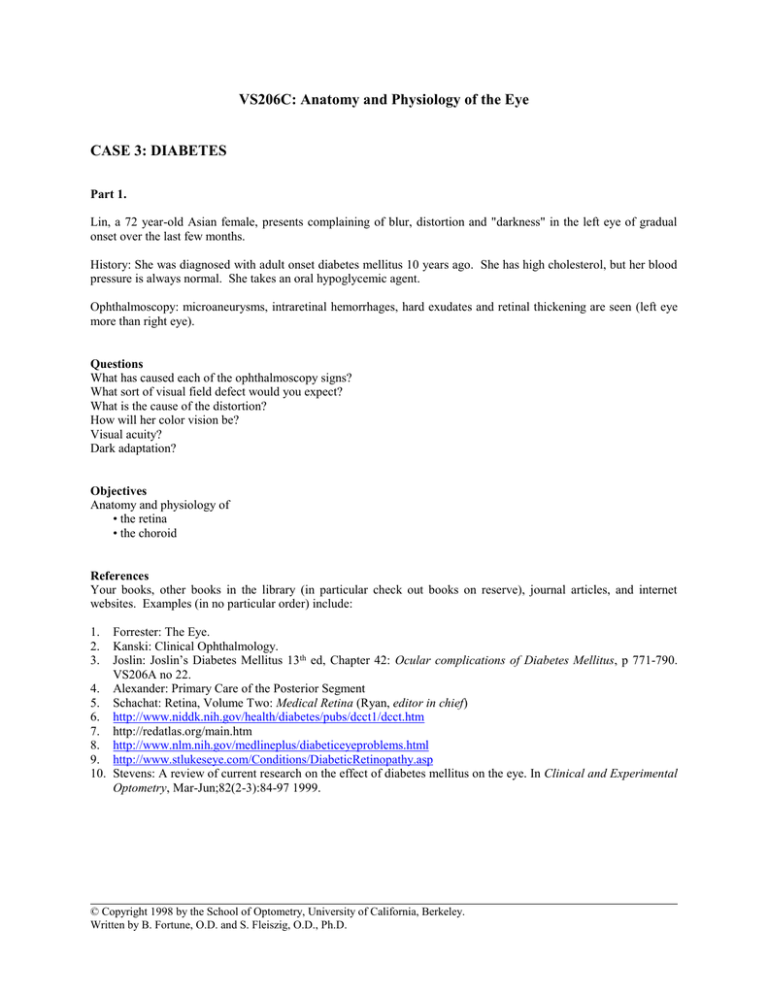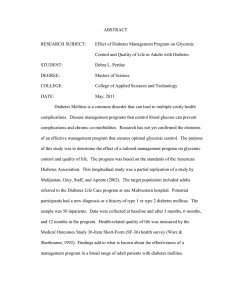Case 3
advertisement

VS206C: Anatomy and Physiology of the Eye CASE 3: DIABETES Part 1. Lin, a 72 year-old Asian female, presents complaining of blur, distortion and "darkness" in the left eye of gradual onset over the last few months. History: She was diagnosed with adult onset diabetes mellitus 10 years ago. She has high cholesterol, but her blood pressure is always normal. She takes an oral hypoglycemic agent. Ophthalmoscopy: microaneurysms, intraretinal hemorrhages, hard exudates and retinal thickening are seen (left eye more than right eye). Questions What has caused each of the ophthalmoscopy signs? What sort of visual field defect would you expect? What is the cause of the distortion? How will her color vision be? Visual acuity? Dark adaptation? Objectives Anatomy and physiology of • the retina • the choroid References Your books, other books in the library (in particular check out books on reserve), journal articles, and internet websites. Examples (in no particular order) include: 1. 2. 3. Forrester: The Eye. Kanski: Clinical Ophthalmology. Joslin: Joslin’s Diabetes Mellitus 13th ed, Chapter 42: Ocular complications of Diabetes Mellitus, p 771-790. VS206A no 22. 4. Alexander: Primary Care of the Posterior Segment 5. Schachat: Retina, Volume Two: Medical Retina (Ryan, editor in chief) 6. http://www.niddk.nih.gov/health/diabetes/pubs/dcct1/dcct.htm 7. http://redatlas.org/main.htm 8. http://www.nlm.nih.gov/medlineplus/diabeticeyeproblems.html 9. http://www.stlukeseye.com/Conditions/DiabeticRetinopathy.asp 10. Stevens: A review of current research on the effect of diabetes mellitus on the eye. In Clinical and Experimental Optometry, Mar-Jun;82(2-3):84-97 1999. © Copyright 1998 by the School of Optometry, University of California, Berkeley. Written by B. Fortune, O.D. and S. Fleiszig, O.D., Ph.D. Part 2. More history: Lin had an extracapsular extraction and an intraocular lens implant in the left eye 4 years ago. When she was originally diagnosed she had complained of transient blur that came and went during the day (myopic shift). Future: When she is examined again at 78 she has neovascularization on the disc and her IOP in this eye is 55. There are lots of perfectly round, regular spaced and regular sized, light patches all over the fundus. When a bright light is shone into this eye the pupils do not constrict as much as when the same light is shone into the other eye. She requires an extra half of a diopter of power in her reading glasses. Occasionally she has double vision. Questions: Why did she undergo a myopic shift? What is the mechanism? What caused the neovascularization? Why is the IOP raised? What are the white areas and why are they there? Why does she have double vision (clue: eye muscles)? What is the biggest complication of the neovascularization on the disc? (Clue: think vitreous) How does this happen? Do you think that the change in her reading prescription relates to the diabetes? Why is the pupil reflex altered? Objectives – same as for part 1, but also: Anatomy and physiology of: • the vitreous • the lens • the iris Review anterior eye as it relates to this case if required (effects of diabetes on anterior eye??) References Your books, other books in the library (in particular check out books on reserve), journal articles, and internet websites. Examples (in no particular order) include: 1. 2. 3. Swann: Non-retinal ocular changes in diabetes. In Clinical and Experimental Optometry, 1999. Harper: Treatment of diabetic retinopathy. In Clinical and Experimental Optometry, 1999. Cockburn: Diabetic retinopathy: classification, description and optometric management. In Clinical and Experimental Optometry, 1999. © Copyright 1998 by the School of Optometry, University of California, Berkeley. Written by B. Fortune, O.D. and S. Fleiszig, O.D., Ph.D.




